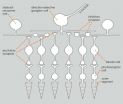(Press-News.org) A polite act shows respect. But a new study of a common etiquette—holding a door for someone—suggests that courtesy may have a more practical, though unconscious, shared motivation: to reduce the work for those involved. The research, by Joseph P. Santamaria and David A. Rosenbaum of Pennsylvania State University, is the first to combine two fields of study ordinarily considered unrelated: altruism and motor control. It is to be published in a forthcoming issue of Psychological Science, a journal of the Association for Psychological Science.
"The way etiquette has been viewed by Emily Post—that you're being proper by following social codes—is undoubtedly part of it," said psychology professor Rosenbaum. "Our insight is there is another contributor: the mental representation of other people's physical effort. Substantial research in the field of motor control shows that people are good at estimating how much effort they and others expend," Rosenbaum continued. "We realized that this concept could be extended to a shared-effort model of politeness."
The researchers videotaped people approaching and passing through the door of a university building. The tapes were analyzed for the relationships among several behaviors: Did the first person hold the door for a follower or followers and for how long? How did the likelihood of holding the door depend on the distance between the first person at the door and whomever followed?
"The most important result," Rosenbaum said, "was that when someone reached the door and two people followed, the first person at the door held the door longer than if only one person followed. The internal calculation on the part of the first arriver was, 'My altruism will benefit more people, so I'll hold the door longer.'"
Another finding: the followers who noticed the door-holder hastened their steps, helping to "fulfill the implicit pact" between themselves and the opener "to keep their joint effort below the sum of their individual door-opening efforts," the authors write.
A more common explanation of why we extend a physical gesture of courtesy is what the researchers term the "critical distance" model: we do something for someone if she is simply near enough. But the researchers found that model insufficient. "We need a way of describing why there is a change of probability" both of doing the task and of expending more time at it, said Rosenbaum. Is the critical distance 10 feet? Why not 50 feet? What is "near enough?" And why wait longer if more people are following? "You still come back to the question of what the individuals are trying to achieve."
Rosenbaum sees the shared-effort model as enhancing, not detracting from, our appreciation of good manners: "Here are people who will probably never see each other again," he says, "but in this fleeting interaction, they reduce each others' effort. This small gesture is uplifting for society."
###
For more information about this study, please contact David A. Rosenbaum dar12@psu.edu.
The APS journal Psychological Science is the highest ranked empirical journal in psychology. For a copy of the article "Etiquette and Effort: Holding Doors for Others" and access to other Psychological Science research findings, please contact Tiffany Harrington at 202-293-9300 or tharrington@psychologicalscience.org.
More reasons to be nice: It's less work for everyone
2011-03-10
ELSE PRESS RELEASES FROM THIS DATE:
Rutgers researchers identify materials that may deliver more 'bounce'
2011-03-10
NEW BRUNSWICK, N.J. – Rutgers researchers have identified a class of high-strength metal alloys that show potential to make springs, sensors and switches smaller and more responsive.
The alloys could be used in springier blood vessel stents, sensitive microphones, powerful loudspeakers, and components that boost the performance of medical imaging equipment, security systems and clean-burning gasoline and diesel engines.
While these nanostructured metal alloys are not new – they are used in turbine blades and other parts demanding strength under extreme conditions – ...
When leukemia returns, gene that mediates response to key drug often mutated
2011-03-10
(MEMPHIS, Tenn. – March 9, 2011) Despite dramatically improved survival rates for childhood acute lymphoblastic leukemia (ALL), relapse remains a leading cause of death from the disease. Work led by St. Jude Children's Research Hospital investigators identified mutations in a gene named CREBBP that may help the cancer resist steroid treatment and fuel ALL's return.
CREBBP plays an important role in normal blood cell development, helping to switch other genes on and off. In this study, researchers found that 18.3 percent of the 71 relapsed-ALL patients carried alterations ...
Gene variant influences chronic kidney disease risk
2011-03-10
A team of researchers from the United States and Europe has identified a single genetic mutation in the CUBN gene that is associated with albuminuria both with and without diabetes. Albuminuria is a condition caused by the leaking of the protein albumin into the urine, which is an indication of kidney disease.
The research team, known as the CKDGen Consortium, examined data from several genome-wide association studies to identify missense variant (I2984V) in the CUBN gene. The association between the CUBN variant and albuminuria was observed in 63,153 individuals with ...
New microscope decodes complex eye circuitry
2011-03-10
VIDEO:
Ganglion cells preferentially form synapses with those amacrine cells whose dendrites run in the direction opposite -- seen from the ganglion cell - to the preferred direction of motion (amacrine...
Click here for more information.
The sensory cells in the retina of the mammalian eye convert light stimuli into electrical signals and transmit them via downstream interneurons to the retinal ganglion cells which, in turn, forward them to the brain. The interneurons ...
Physicists measure current-induced torque in nonvolatile magnetic memory devices
2011-03-10
ITHACA, N.Y. - Tomorrow's nonvolatile memory devices – computer memory that can retain stored information even when not powered – will profoundly change electronics, and Cornell University researchers have discovered a new way of measuring and optimizing their performance.
Using a very fast oscilloscope, researchers led by Dan Ralph, the Horace White Professor of Physics, and Robert Buhrman, the J.E. Sweet Professor of Applied and Engineering Physics, have figured out how to quantify the strength of current-induced torques used to write information in memory devices ...
NASA and other satellites keeping busy with this week's severe weather
2011-03-10
Satellites have been busy this week covering severe weather across the U.S. Today, the GOES-13 satellite and NASA's Aqua satellite captured an image of the huge stretch of clouds associated with a huge and soggy cold front as it continues its slow march eastward. Earlier this week, NASA's Tropical Rainfall Measuring Mission satellite captured images of severe weather that generated tornadoes over Louisiana.
Today the eastern third of the U.S. is being buffered by a large storm that stretches from southeastern Minnesota east to Wisconsin and Michigan, then south through ...
International panel revises 'McDonald Criteria' for diagnosing multiple sclerosis
2011-03-10
International Panel Revises "McDonald Criteria" for Diagnosing MS -- Use of new data should speed diagnosis -- Publication coincides with MS Awareness Week
An international panel has revised and simplified the "McDonald Criteria" commonly used to diagnose multiple sclerosis, incorporating new data that should speed the diagnosis without compromising accuracy. The International Panel on Diagnosis of MS, organized and supported by the National MS Society and the European Committee for Treatment and Research in Multiple Sclerosis, was chaired by Chris H. Polman, MD, PhD ...
MIT scientists identify new H1N1 mutation that could allow virus to spread more easily
2011-03-10
CAMBRIDGE, Mass. -- In the fall of 1917, a new strain of influenza swirled around the globe. At first, it resembled a typical flu epidemic: Most deaths occurred among the elderly, while younger people recovered quickly. However, in the summer of 1918, a deadlier version of the same virus began spreading, with disastrous consequence. In total, the pandemic killed at least 50 million people — about 3 percent of the world's population at the time.
That two-wave pattern is typical of pandemic flu viruses, which is why many scientists worry that the 2009 H1N1 ("swine") flu ...
New study proves the brain has 3 layers of working memory
2011-03-10
Researchers from Rice University and Georgia Institute of Technology have found support for the theory that the brain has three concentric layers of working memory where it stores readily available items. Memory researchers have long debated whether there are two or three layers and what the capacity and function of each layer is.
In a paper in the March issue of the Journal of Cognitive Psychology, researchers found that short-term memory is made up of three areas: a core focusing on one active item, a surrounding area holding at least three more active items, and a ...
Giving children the power to be scientists
2011-03-10
Children who are taught how to think and act like scientists develop a clearer understanding of the subject, a study has shown.
The research project led by The University of Nottingham and The Open University has shown that school children who took the lead in investigating science topics of interest to them gained an understanding of good scientific practice.
The study shows that this method of 'personal inquiry' could be used to help children develop the skills needed to weigh up misinformation in the media, understand the impact of science and technology on everyday ...


